 Primordial sea was technically the most challenging quilt I have ever made. I arranged all the elements of my design in Photoshop and printed it out to size on close to 100- 8 1/2"x 11" sheets of paper. I arrange the pages on the floor and tape them together with clear packing tape. It makes a large strong cartoon (artist preliminary sketch) with all the tape reinforcement. I start all my large quilts this way.
Primordial sea was technically the most challenging quilt I have ever made. I arranged all the elements of my design in Photoshop and printed it out to size on close to 100- 8 1/2"x 11" sheets of paper. I arrange the pages on the floor and tape them together with clear packing tape. It makes a large strong cartoon (artist preliminary sketch) with all the tape reinforcement. I start all my large quilts this way.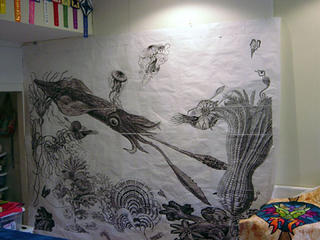 I wanted to use silk for this quilt, the luminous way light reflects from it would be ideal for water. I ordered the widest silk charmuese I could get from Dharma Trading and sewed two pieces together to make a 6 foot by 8 foot wide panel of silk. Then I hand dyed it twice in shades of turquoise, cerulean and navy.
I wanted to use silk for this quilt, the luminous way light reflects from it would be ideal for water. I ordered the widest silk charmuese I could get from Dharma Trading and sewed two pieces together to make a 6 foot by 8 foot wide panel of silk. Then I hand dyed it twice in shades of turquoise, cerulean and navy.I tried tracing my design on to the silk using a light box but found the blue to dark to see through. So I re-taped my fabric under my design and used white Saral transfer paper to transfer the image.
I began to paint and found out two things. One- silk stretches and two- translucent textile paint turns black when you paint on blue silk. To solve the first problem freezer paper became my best friend. Each time I painted an area I ironed a strip of freezer paper to the back of my fabric. Then I carefully painted up close to the edge of the paper, then repositioned the freezer paper adjacent and just underneath the area I was painting so I would not get a line from the paper showing up in the paint. Any little bump or grain of sand under the fabric will show up in the painting.
To solve the next problem I painted each object in shades of white to create a base for the paint colors, allowing the blue fabric to show through in the areas I wanted the darkest shades.
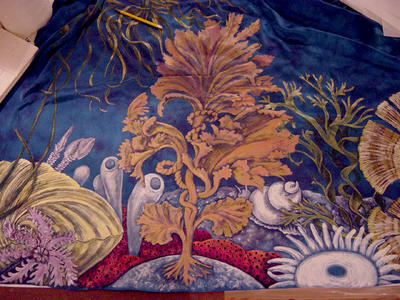 The next problem I ran into, was the chalk lines from the Saral paper started to rub off and disappear as I worked. I found myself having to rely on looking up at the original cartoon on the wall and re drawing things by hand because there would be no way to realign the drawing and quilt again and re transfer the images. So things changed shape sometimes and had different kinds of details. This is also when I started to add things that were not in the original cartoon, like several more types of seaweed, a sponge, a large pink anemone, a trilobite, a clam and a snail.
The next problem I ran into, was the chalk lines from the Saral paper started to rub off and disappear as I worked. I found myself having to rely on looking up at the original cartoon on the wall and re drawing things by hand because there would be no way to realign the drawing and quilt again and re transfer the images. So things changed shape sometimes and had different kinds of details. This is also when I started to add things that were not in the original cartoon, like several more types of seaweed, a sponge, a large pink anemone, a trilobite, a clam and a snail. You can see the lines for the giant sea lilly have all but disappeared.
You can see the lines for the giant sea lilly have all but disappeared.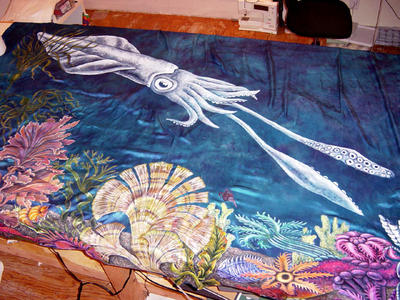
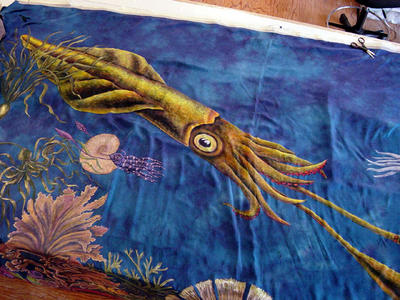
Finished Painting.
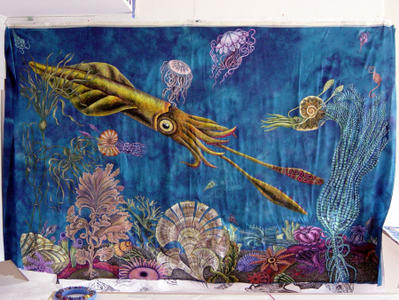
I was terrified to quilt this quilt. One; it was big, two; I was using slippery silk and slippery wool batting, and three; any mistakes in the quilting (puckers in the fabric, stitches that need to be removed) were really going to show. I thought of spray baste, but was afraid of its chemical effect on the silk and what if it stained it with splatters? Also where would I be able to lay a piece of silk this big outside safely to spray, and after vigorous manipulation while machine quilting, would it loose its adhesion? Hand basting seemed too daunting on this one. Then I thought of fusible web. Something I am ambivalent to use because I do not like the stiff flat quality. Wool batting has a lot of loft and you would lose all that texture by using something like wonder under. I remember Esterita Austin saying that she had a new fusible web product that was very light. So when she came to teach at our Glendale, CA Quilt show I bought a package of Misty Fuse.
I made a sample using the fusible web, sandwiched between a piece of silk and wool batting. I loved the results. The fusible is like a spider web it is so light. I fused the whole hand dyed and painted sheet of silk to the wool batting, very carefully in two steps.
First I fused the web to the silk in rows, using parchment paper as a backing sheet. The slight overlaps were invisible after fusing. Then on the backing fabric, I fused a one-inch square of web every 6 inches and fused it to one side of the batting. Next I spread the fused backing and batting on the largest carpeted floor in the house and carefully fused my silk top to the wool batting starting in the center and working outwards. This took hours, but it was well worth it. The Mistyfuse held up like a dream under heavy machine quilting, it never lost its adhesion.
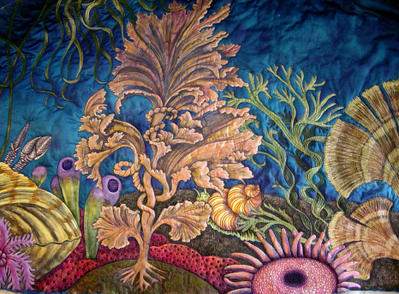
When I start my quilting, I always try to think about how my stitching lines could enhance the image that I am quilting. What kind of detail can I add? How can the quilting make the object appear more dimensional or textured?

You would not think thread would make such a big difference to the work when you are doing the quilting. But look at the difference in the quilted fin of the squid and the unquilted one. The quilted side is so much richer.

While discussing the quilting of the water online with my art quilt group, Vickie Hallmark mentioned putting plankton into the quilting. What a great idea! There are lots of little plankton hidden in the quilting of the water all over the quilt.
 Quilters always like to look at backs of quilts. For a long time I thought that was kind of strange. But I kind of get it now. It is fun to see the picture with out all the color, and see all that crazy quilting.
Quilters always like to look at backs of quilts. For a long time I thought that was kind of strange. But I kind of get it now. It is fun to see the picture with out all the color, and see all that crazy quilting.
I hate doing labels, so I thought I would try and have more fun with this one. It is painted and quilted.







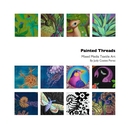
























This is amazing. I would love to see it in person and touch it.
ReplyDeleteThe texture has to be wonderful to the touch.
Your detail work makes this simply awe inspiring.
I am so glad I found your blog. Thanks for creating the project blog!
Beyond amazing!! Glad I found your blog too...I'm also an art quilter (if I can even call myself that in light of what you do!) I'll be visiting here often!
ReplyDeleteWOW....that is just wonderful...the colours so rich, subject matter and design different and interesting.The use of silk and the colour really made it seem deep, dark and mysterious. The quilting enhancements made such a difference.
ReplyDeleteAlmost as wonderful was your description of the process. I have only just discovered fibre art and found this so educational and inspiring. Thank you for taking the time out to give such an indepth look at the creative journey. I too am glad to have found your blog.
Shirley
Thanks Shirley,
ReplyDeleteI feel like when people see the process there is a much greater understanding of what they are seeing. It is especially hard seeing art on a computer screen or in a book. It just isn't the same. I learned so much making this quilt, it felt like a major accomplishment when it was done. I am glad to share any insights and experiences I had while doing it. Maybe I will save some one a lot of frustration, lol.
The shading using the blue of the silk worked so well! It's beautiful, thanks for sharing your process and difficulties...wow.
ReplyDeleteThank you for showing us the details on this quilt. It's absolutely stunning.
ReplyDeleteHi Judy, This is ammmaaaaazzzzzzzzing and wonderful and so very kind and generous of you to share your process. I love your sense of experimentation and also to hear the fear in what you were attempting. Wow. I enjoyed reading how you were learning as you went. Thanks so much for sharing.
ReplyDeleteI love it! You doing an amazing amount of very tight/dense quilting. What batting do you prefer? Amy
ReplyDeleteAmy,
ReplyDeleteI like Hobbs Heirloom wool batting and if I can I like to get it off the bolt instead of by the bag. When it comes off the bolt the batting is very uniform in density and is easy to lay out flat for a quilt. When it comes out of the bag sometimes it has thick and thin spots (although very minor) and wrinkles that need a day to relax by laying it out flat.
Howdy Judy,
ReplyDeleteOutstanding work! How long did this quilt project take?
I love your post, design, composition, color, material and quilting! I own some art quilts by Jane Sassaman, and even though I'm not a textile artist (yet) I can appreciate the details and all the work of such an exquisite piece.
THis looks like an award winning quilt from here!
Would love for you to visit my blog when you have a moment or 2.
Check out my mixed-media giveaway too.
Peace,
LuLu
www.lulu-too-beaucoup.blogspot.com/2012/03/giveaway-giveaway-awesome-artists.html
Thanks LuLu, I spent one month on the painting and three months on construction and quilting.
ReplyDelete